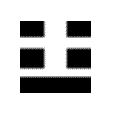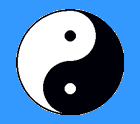Chapter III
Methodology
This study examines the ancient
practice and tradition of qigong, a component of Traditional Chinese
Medicine, and its adaptation into contemporary American culture as
an alternative or complementary health care modality. My research
was an outgrowth of seven years of experience with the concept of
qi from training in the martial arts, where I first learned of TCM
and was intrigued by its energetic concept of the universe.
This interest eventually led me to a four year study of the "mysteries"
of qi which led to my seeking practitioners of qigong.
Research Methods
Both qualitative and quantitative
data collection methods were utilized in this study. The qualitative
method centered on ethnographic data collected mainly in the form
of participant observation and personal interviews. With
three of the ethnographic informants I assumed the role of a student/apprentice;
and, I still continue in this capacity learning each subjects' particular
form of healing in depth and progressing to higher levels. The quantitative
data were collected by means of a standardized survey instrument.
Additionally, research of the literature permitted a greater depth
of understanding and interpretative capability to both the qualitative
and quantitative data that were collected.
In researching qigong there
are basically three main groups of concern. First, the qigong
master healer who can use his qigong ability to cure others.
Second, the qigong master martial artist who uses qigong to improve
his martial effectiveness but, can also use it to heal. Finally,
the qigong practitioner who simply does qigong for their own personal
health and longevity. Further, qigong can be broken down into
external and internal forms and active and passive forms.
The most logical focus for
survey research was the largest group of "qigong practitioners"
because it was inclusive of the other two groups of "qigong master
healers" and "qigong master martial artists." As qigong is still
a relatively young practice in the United States, it was difficult
to find a sizable population to utilize for survey research.
There are several qigong groups and practitioners in the U.S., however,
they are geographically spread all over the country. The method
that was utilized to overcome the distance problem was the utilization
of new technology. A survey of qigong practitioners, who had
practiced qigong for a minium of six months, was posted on the World
Wide Web (WWW). The use of the WWW in the survey facilitated
collection of data from various individuals that could otherwise not
have ever been identified for a survey. The minimum practice
time requirement was determined both from opinions expressed in much
of the literature and additionally from many qigong experienced informants.
The survey utilized was the Duke Health Profile (see appendix) which
was adapted to use on the WWW. The Duke is seventeen question,
self-administered, questionnaire instrument that measures six function
scales and five dysfunction scales to report functional health status
during a one week period. Requests to complete the survey were
sent to several email discussion groups that had connections to the
topic of qigong, these consisted of martial arts, alternative
healing, and qigong specific groups. Fifty-two qigong practitioners
completed the survey for the experimental group. Then a comparison
group of non-qigong practitioners was surveyed and resulted in 25
respondents for the control group. The control group was composed
of members of martial arts discussion groups who felt they did
not practice qigong. Additionally, the survey web site received
over 500 hits and numerous individuals emailed me and indicated interest
in the survey but noted that they did not fill out the survey because
they had not been practicing qigong for the minimum time period required
by the survey. The occurrence of such a large number of hits
possibly indicates an interest and popularization of the subject of
qigong.
Ethnographic Methods
The survey research was supplemented
by utilizing ethnographic data collected from representatives of the
three types of qigong groups and a yoga instructor, as yoga is conceptually
and methodologically related to qigong yet, culturally distinct.
The ethnographic component can assist in observing how this
component of Oriental medicine and culture is being integrated into
the American popular culture phenomenon of alternative and complementary
health care. The ethnographic data were collected by personal
interviews assisted by supplemental communication by email, observation,
and participant observation.
Locating the research subjects
was a complicated process. My literature review provided an
initial basis to begin with and I located several possible subjects
within a reasonable geographic proximity. Several possible subjects
I initially contacted indicated interest in participating in my study
but, for various reasons became unavailable. One of my primary
sources for locating possible research subjects was the Internet which
eventually lead to my finding several suitable subjects and one subject
even made initial contact with me.
One of the most interesting
things I found during my ethnographic work was the interest shown
by energetic healers in being studied. Many informants expressed
interest in participating in more in-depth study of themselves involving
hard science experiments of their techniques. These informants
expressed belief that the results of their practice would lend itself
to measurement or quantification in some way.
In my work with a qigong healer,
a qigong martial artist and a yoga teacher my research took the form
of assuming the status of a student and fitting into the category
of qigong practitioner. I learned and practiced the healing
methods taught by these individuals and would communicate with them
on a regular basis about the training process. As well, I was
able to observe the interaction of my "teachers" with other students
and patients and speak with them about their experiences with these
healing methods.
The work with my other informants
took the form of participant observation with less in-depth communication.
This is due to the nature of the other research subjects. One
of these was a group of people with their healing practice focused
on weekly meetings of the group. Because of this group dynamic,
I focused more on the group than on individuals and assumed the role
of group participant as a qigong practitioner. Another subject
was a professional in a healing modality which requires formal education
and licensing and limited the role I could assume to interviewer or
participant observation in the status of patient.
From these various roles and
statuses I was able to gain a fuller picture of the healing process
and of the similarities and differences between the approaches used
by each of these individuals. The concept of the energetics
of the human body were all very similar in all approaches. The
similarity of some of the energetic healing techniques among the subjects
was quite an interesting occurrence as well.
The main emphasis of all the
methods is grounded in prevention and maintenance of health.
A common belief of all of my subjects was that they could initially
help a patient, but ultimately the patients' health has to be
the patients responsibility. Americans taking responsibility
for their own health would most certainly help to resolve our current
and expensive cure based philosophy.
In our own era, even after the development of scientific
medicine, the idea of an approach to health
based on curing, even of miracle cures (think of the term
"medical miracle" as it is applied to the latest
surgical intervention) has persisted. It
is still a seductive dream. Cures are sought that can compensate,
not for unknown or misunderstood causes
of illness, but for well-known abuses the body
the individual and society have themselves perpetuated--correcting
at a stroke the effects of cigarette smoking,
or of breathing polluted air, or of working in an unhealthy
workplace over a period of years.
(1995 Kovner 13)
Chapter 4


